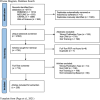Competency-based education and training for Community Health Workers: a scoping review
- PMID: 39962470
- PMCID: PMC11834664
- DOI: 10.1186/s12913-025-12217-7
Competency-based education and training for Community Health Workers: a scoping review
Abstract
Background: Community Health Workers (CHWs) play a critical role in supporting the delivery of health services globally. Competency-based learning programs can improve the transfer of learning to practice. This scoping review aims to characterize the published literature on competency-based education as an instructional and curricular strategy in community health worker training programs. We conducted a scoping review of the literature to identify how, by who, and in what ways CHWs are trained using competency-based education; and to characterize the extent of available evidence, as well as the gaps in that evidence.
Methods: We conducted a review of the peer-reviewed literature on CHW competency-based education and training published between January 2010 to March 2023, drawing from four databases: EMBASE, OVID Medline, Web of Science, and CINAHL. We followed the PRISMA guidelines for scoping reviews. A total of 713 articles were reviewed and 236 were included for extraction based on the inclusion and exclusion criteria. Due to methodological heterogeneity, results were analyzed and synthesized only through a descriptive approach.
Results: The literature on competency-based CHW education and training is most voluminous in high income contexts, primarily the USA. Overall, the included studies described very small-scale training interventions. Study types included observational (qualitative, quantitative, mixed methods, case studies) intervention or experimental studies, systematic or scoping reviews, and literature reviews. The most common practice area included was 'promotive and preventive services', whereas 'personal safety' was the rarest. Learning programs tailored to CHWs with low-literacy, content tailored to local cultural contexts, and curricula that were co-designed with CHWs were identified in the literature as effective strategies for converting learning to practice. Information on institutional support for CHWs was not provided in most of the articles reviewed. While the focus of our review was on education and training and not broader supports for CHWs, we still found it notable that training was usually discussed in isolation from other related supportive factors, including professionalization and career progression.
Conclusions: We found considerable academic interest in utilizing competency-based education to support CHWs and improve their work, yet this exploration was largely limited to smaller, ad hoc programs, in high income settings. Learning programs should be tailored to the realities and practice requirements of CHWs. Further work should illuminate the extent to which the design and delivery of education and training activities lead to acquiring and maintaining the requisite competencies.
Keywords: Community Health Workers; Competency-based Education; Education; Health Workforce; Scoping Review; Training.
© 2025. The Author(s).
Conflict of interest statement
Declarations. Ethics approval and consent to participate: Not applicable. Consent for publication: Not applicable. Competing Interests: The authors declare no competing interests.
Figures






Similar articles
-
Beyond the black stump: rapid reviews of health research issues affecting regional, rural and remote Australia.Med J Aust. 2020 Dec;213 Suppl 11:S3-S32.e1. doi: 10.5694/mja2.50881. Med J Aust. 2020. PMID: 33314144
-
Changes in blood pressure among users of lay health worker or volunteer operated community-based blood pressure programs over time: a systematic review protocol.JBI Database System Rev Implement Rep. 2015 Oct;13(10):30-40. doi: 10.11124/jbisrir-2015-1927. JBI Database System Rev Implement Rep. 2015. PMID: 26571280
-
Ongoing training of community health workers in low-income andmiddle-income countries: a systematic scoping review of the literature.BMJ Open. 2018 Apr 28;8(4):e021467. doi: 10.1136/bmjopen-2017-021467. BMJ Open. 2018. PMID: 29705769 Free PMC article.
-
Community health workers involvement in preventative care in primary healthcare: a systematic scoping review.BMJ Open. 2019 Dec 17;9(12):e031666. doi: 10.1136/bmjopen-2019-031666. BMJ Open. 2019. PMID: 31852698 Free PMC article.
-
What do we know about community-based health worker programs? A systematic review of existing reviews on community health workers.Hum Resour Health. 2018 Aug 16;16(1):39. doi: 10.1186/s12960-018-0304-x. Hum Resour Health. 2018. PMID: 30115074 Free PMC article.
Cited by
-
Evaluating the impact of a community health worker training program.J Health Popul Nutr. 2025 Jul 15;44(1):256. doi: 10.1186/s41043-025-01011-0. J Health Popul Nutr. 2025. PMID: 40665459 Free PMC article.
-
Impact of Competency-Based Education and Multidisciplinary Team Teaching for Standardized Training Resident on Radiation Oncology.J Cancer Educ. 2025 Jul 12. doi: 10.1007/s13187-025-02686-z. Online ahead of print. J Cancer Educ. 2025. PMID: 40650730
-
Home Health Care Providers' Readiness to Care for Children and Youth With Complex Medical Conditions: Protocol for a Scoping Review.JMIR Res Protoc. 2025 Jul 4;14:e76796. doi: 10.2196/76796. JMIR Res Protoc. 2025. PMID: 40613600 Free PMC article.
-
Regional variations in Mediterranean diet adherence: a sociodemographic and lifestyle analysis across Mediterranean and non-Mediterranean regions within the MEDIET4ALL project.Front Public Health. 2025 Jun 10;13:1596681. doi: 10.3389/fpubh.2025.1596681. eCollection 2025. Front Public Health. 2025. PMID: 40556924 Free PMC article.
References
-
- Neupane D, Kallestrup P, McLachlan CS, Perry H. Community health workers for non-communicable diseases. Lancet Glob Health. 2014;2(10):e567. - PubMed
Publication types
MeSH terms
Grants and funding
LinkOut - more resources
Full Text Sources

